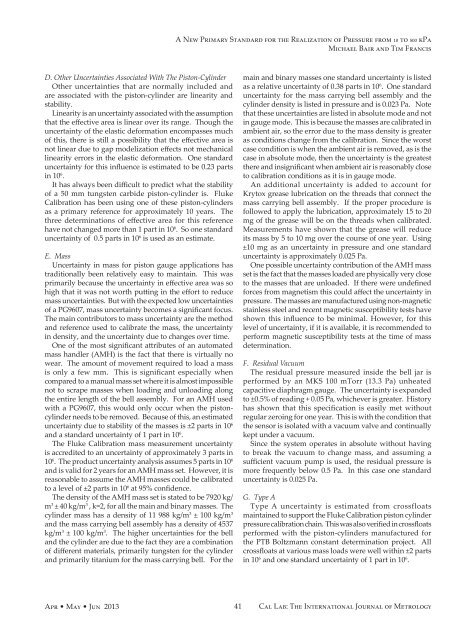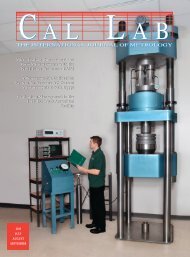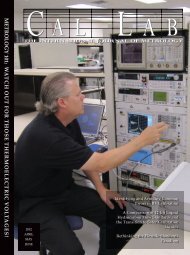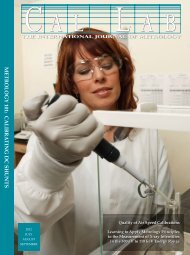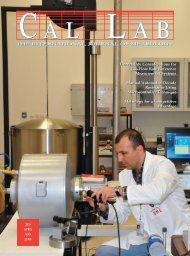METROLOGY 101: PISTON PROVER DESIGN - Cal Lab Magazine
METROLOGY 101: PISTON PROVER DESIGN - Cal Lab Magazine
METROLOGY 101: PISTON PROVER DESIGN - Cal Lab Magazine
Create successful ePaper yourself
Turn your PDF publications into a flip-book with our unique Google optimized e-Paper software.
A New Primary Standard for the Realization of Pressure from 10 to 500 kPa<br />
Michael Bair and Tim Francis<br />
D. Other Uncertainties Associated With The Piston-Cylinder<br />
Other uncertainties that are normally included and<br />
are associated with the piston-cylinder are linearity and<br />
stability.<br />
Linearity is an uncertainty associated with the assumption<br />
that the effective area is linear over its range. Though the<br />
uncertainty of the elastic deformation encompasses much<br />
of this, there is still a possibility that the effective area is<br />
not linear due to gap modelization effects not mechanical<br />
linearity errors in the elastic deformation. One standard<br />
uncertainty for this influence is estimated to be 0.23 parts<br />
in 10 6 .<br />
It has always been difficult to predict what the stability<br />
of a 50 mm tungsten carbide piston-cylinder is. Fluke<br />
<strong>Cal</strong>ibration has been using one of these piston-cylinders<br />
as a primary reference for approximately 10 years. The<br />
three determinations of effective area for this reference<br />
have not changed more than 1 part in 10 6 . So one standard<br />
uncertainty of 0.5 parts in 10 6 is used as an estimate.<br />
E. Mass<br />
Uncertainty in mass for piston gauge applications has<br />
traditionally been relatively easy to maintain. This was<br />
primarily because the uncertainty in effective area was so<br />
high that it was not worth putting in the effort to reduce<br />
mass uncertainties. But with the expected low uncertainties<br />
of a PG9607, mass uncertainty becomes a significant focus.<br />
The main contributors to mass uncertainty are the method<br />
and reference used to calibrate the mass, the uncertainty<br />
in density, and the uncertainty due to changes over time.<br />
One of the most significant attributes of an automated<br />
mass handler (AMH) is the fact that there is virtually no<br />
wear. The amount of movement required to load a mass<br />
is only a few mm. This is significant especially when<br />
compared to a manual mass set where it is almost impossible<br />
not to scrape masses when loading and unloading along<br />
the entire length of the bell assembly. For an AMH used<br />
with a PG9607, this would only occur when the pistoncylinder<br />
needs to be removed. Because of this, an estimated<br />
uncertainty due to stability of the masses is ±2 parts in 10 6<br />
and a standard uncertainty of 1 part in 10 6 .<br />
The Fluke <strong>Cal</strong>ibration mass measurement uncertainty<br />
is accredited to an uncertainty of approximately 3 parts in<br />
10 6 . The product uncertainty analysis assumes 5 parts in 10 6<br />
and is valid for 2 years for an AMH mass set. However, it is<br />
reasonable to assume the AMH masses could be calibrated<br />
to a level of ±2 parts in 10 6 at 95% confidence.<br />
The density of the AMH mass set is stated to be 7920 kg/<br />
m 3 ± 40 kg/m 3 , k=2, for all the main and binary masses. The<br />
cylinder mass has a density of 11 988 kg/m 3 ± 100 kg/m 3<br />
and the mass carrying bell assembly has a density of 4537<br />
kg/m 3 ± 100 kg/m 3 . The higher uncertainties for the bell<br />
and the cylinder are due to the fact they are a combination<br />
of different materials, primarily tungsten for the cylinder<br />
and primarily titanium for the mass carrying bell. For the<br />
main and binary masses one standard uncertainty is listed<br />
as a relative uncertainty of 0.38 parts in 10 6 . One standard<br />
uncertainty for the mass carrying bell assembly and the<br />
cylinder density is listed in pressure and is 0.023 Pa. Note<br />
that these uncertainties are listed in absolute mode and not<br />
in gauge mode. This is because the masses are calibrated in<br />
ambient air, so the error due to the mass density is greater<br />
as conditions change from the calibration. Since the worst<br />
case condition is when the ambient air is removed, as is the<br />
case in absolute mode, then the uncertainty is the greatest<br />
there and insignificant when ambient air is reasonably close<br />
to calibration conditions as it is in gauge mode.<br />
An additional uncertainty is added to account for<br />
Krytox grease lubrication on the threads that connect the<br />
mass carrying bell assembly. If the proper procedure is<br />
followed to apply the lubrication, approximately 15 to 20<br />
mg of the grease will be on the threads when calibrated.<br />
Measurements have shown that the grease will reduce<br />
its mass by 5 to 10 mg over the course of one year. Using<br />
±10 mg as an uncertainty in pressure and one standard<br />
uncertainty is approximately 0.025 Pa.<br />
One possible uncertainty contribution of the AMH mass<br />
set is the fact that the masses loaded are physically very close<br />
to the masses that are unloaded. If there were undefined<br />
forces from magnetism this could affect the uncertainty in<br />
pressure. The masses are manufactured using non-magnetic<br />
stainless steel and recent magnetic susceptibility tests have<br />
shown this influence to be minimal. However, for this<br />
level of uncertainty, if it is available, it is recommended to<br />
perform magnetic susceptibility tests at the time of mass<br />
determination.<br />
F. Residual Vacuum<br />
The residual pressure measured inside the bell jar is<br />
performed by an MKS 100 mTorr (13.3 Pa) unheated<br />
capacitive diaphragm gauge. The uncertainty is expanded<br />
to ±0.5% of reading + 0.05 Pa, whichever is greater. History<br />
has shown that this specification is easily met without<br />
regular zeroing for one year. This is with the condition that<br />
the sensor is isolated with a vacuum valve and continually<br />
kept under a vacuum.<br />
Since the system operates in absolute without having<br />
to break the vacuum to change mass, and assuming a<br />
sufficient vacuum pump is used, the residual pressure is<br />
more frequently below 0.5 Pa. In this case one standard<br />
uncertainty is 0.025 Pa.<br />
G. Type A<br />
Type A uncertainty is estimated from crossfloats<br />
maintained to support the Fluke <strong>Cal</strong>ibration piston cylinder<br />
pressure calibration chain. This was also verified in crossfloats<br />
performed with the piston-cylinders manufactured for<br />
the PTB Boltzmann constant determination project. All<br />
crossfloats at various mass loads were well within ±2 parts<br />
in 10 6 and one standard uncertainty of 1 part in 10 6 .<br />
Apr • May • Jun 2013<br />
41<br />
<strong>Cal</strong> <strong>Lab</strong>: The International Journal of Metrology


